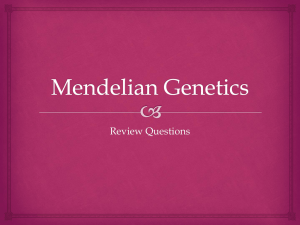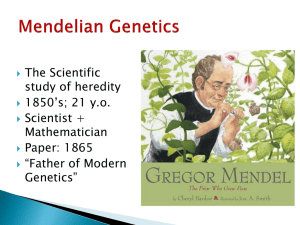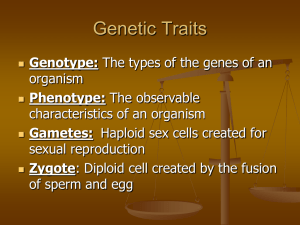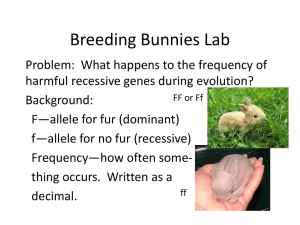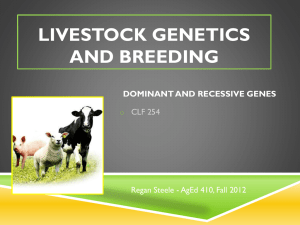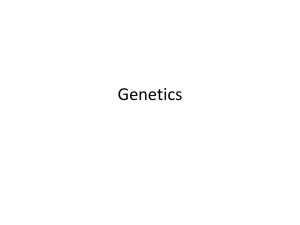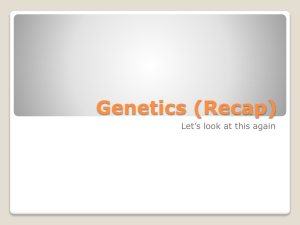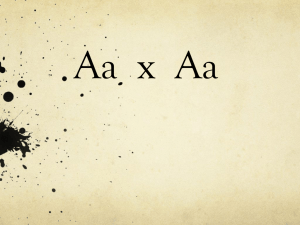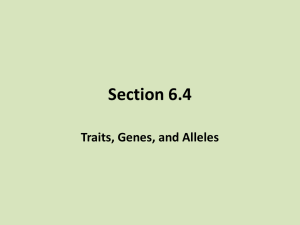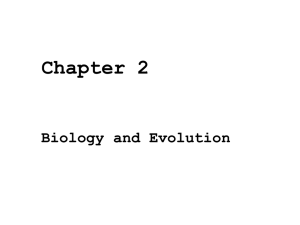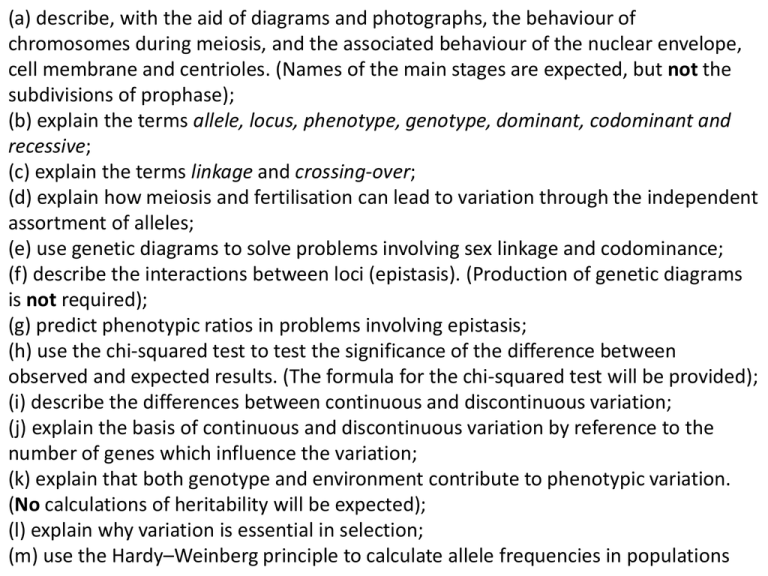
(a) describe, with the aid of diagrams and photographs, the behaviour of
chromosomes during meiosis, and the associated behaviour of the nuclear envelope,
cell membrane and centrioles. (Names of the main stages are expected, but not the
subdivisions of prophase);
(b) explain the terms allele, locus, phenotype, genotype, dominant, codominant and
recessive;
(c) explain the terms linkage and crossing-over;
(d) explain how meiosis and fertilisation can lead to variation through the independent
assortment of alleles;
(e) use genetic diagrams to solve problems involving sex linkage and codominance;
(f) describe the interactions between loci (epistasis). (Production of genetic diagrams
is not required);
(g) predict phenotypic ratios in problems involving epistasis;
(h) use the chi-squared test to test the significance of the difference between
observed and expected results. (The formula for the chi-squared test will be provided);
(i) describe the differences between continuous and discontinuous variation;
(j) explain the basis of continuous and discontinuous variation by reference to the
number of genes which influence the variation;
(k) explain that both genotype and environment contribute to phenotypic variation.
(No calculations of heritability will be expected);
(l) explain why variation is essential in selection;
(m) use the Hardy–Weinberg principle to calculate allele frequencies in populations
Meiosis
Meiosis results in daughter cells having half of the number of
original chromosomes. The daughter cells are haploid and can be
used for sexual reproduction.
Sexual reproductive cells are known as
gametes. They fuse in fertilisation to
produce the first cell of a new
organism called a zygote.
Meiosis involves 2 divisions called
meiosis I and meiosis II. Meiosis I is
a reduction division: 2 daughter nuclei
result with half the number of
chromosomes of the parent nucleus.
During meiosis II, the chromosomes
behave as in mitosis and each of the
haploid daughter cells divide to form
4 haploid daughter cells.
Meiosis in humans occurs in the
testes and ovaries. Diploid (2n)
cells contain 2 sets of
chromosomes – 1 paternal and 1
maternal set. During meiosis,
haploid gametes are formed (n)
containing half the normal
number of chromosomes.
Fertilisation restores the
diploid condition.
Meiosis I: Interphase I
Nuclear
envelope
Nucleolus
DNA replicates
Cell increases in size, making more
membrane
Organelles replicated
Meiosis I: Prophase I
Chromosomes condense and
supercoil
Chromosomes come together in their
homologous pairs forming a bivalent
Non-sister chromatids overlap and
attach at points called chiasmata
They may swap sections of
chromatids with each other: this is
called crossing over
Nucleolus disappears and nuclear
envelope disintegrates.
Homologous pair: One
maternal and one
paternal chromosome,
each with the same
genes at the same loci.
Meiosis I: Metaphase I
Bivalents line up on equator
Spindle fibres attach to centromeres
Chiasmata still present
Random Assortment: bivalents line up randomly
at the equator, with each member of the
homologous pair facing opposite poles, allowing
chromosomes to independently segregate when
pulled apart in anaphase I.
Meiosis I:Anaphase I
Homologous chromosomes in each bivalent are
pulled to opposite poles by spindle fibres
contracting
Centromeres do not divide
Chiasmata separate and lengths of chromatid
that have been crossed over remain with the
chromatid to which they have become newly
attached.
Meiosis I:Telophase I
New nuclear envelopes form – one around each set of chromosomes at the poles
Plasma membrane constricts; cell divides by cytokinesis
2 cells are produced
There is 1 chromosome from each pair in each daughter cell
Chromosome number has been halved
Each chromosome still consists of 2 chromatids
Meiosis II: Interphase II
Very short – sometimes cell will go straight from telophase I to prophase II.
Chromosomes uncoil
No DNA replication
Meiosis II: Prophase II
Nuclear envelope breaks down
Nucleolus disappears
Chromosomes condense
Centrioles move to poles at right angles to
meiosis I
Spindle forms
Meiosis II: Metaphase II
Chromosomes line up at equator
Spindle fibres attach at centromeres
Random assortment: random orientation of
chromosomes on equator
Meiosis II: Anaphase II
Sister chromatids pulled to opposite poles
by spindle fibres contracting
Centromeres divide
Chromatids randomly segregate
Meiosis II: Telophase II
Spindle breaks down
Nuclear envelopes reform
around haploid daughter
nuclei
Plasma membrane
constricts and cell divides
by cytokinesis
4 haploid daughter cells
with unduplicated
chromosomes that are
genetically different are
produced.
Sexual reproduction increases genetic variation, as genetic
material from cells of 2 unrelated organisms combines.
Genetic variation increases the chances of evolution as
natural selection favours organisms that are best adapted
to the ever changing environment.
How does meiosis increase genetic variation?
1.Crossing Over
Crossing over occurs during prophase 1
Non-sister chromatids wrap around each other and attach at points called
chiasmata
Chromosomes break at these points. Broken ends of the chromatids re-join to
the ends of the non-sister chromatid in the same bivalent, resulting in similar
sections of chromatid being swapped over. Often these sections will contain the
same genes but different alleles.
Crossing over produces new combinations of alleles on the chromatids
The chiasmata remain in place during
metaphase, holding the maternal and
paternal chromosomes together on the
equator, so that when they segregate at
anaphase I, one member of each pair goes
to each pole.
2. Re-assortment of Chromosomes
Reassortment is the consequence of the
random distribution of maternal and
paternal chromosomes on the spindle
equator in metaphase I and the subsequent
segregation into 2 daughter nuclei at anaphase
I.
Each gamete acquires a different mixture of
maternal and paternal chromosomes.
3. Re-assortment of Chromatids
Reassortment is the consequence of the random
distribution of chromatids on the spindle equator
in metaphase II
Due to the process of crossing over, sister
chromatids are no longer genetically identical
How the chromatids align in metaphase II
determines how they segregate at anaphase II.
4. Fertilisation
In humans, 1 ovum is released from an ovary
at a time.
There are 300 million genetically different
spermatozoa, and any one can fertilise the
egg.
The genetic information of the 2 unrelated
individuals then fuses to form the zygote.
5. Mutation
DNA mutation can occur during DNA
replication during interphase
Chromosome mutations may occur
Mutation increases variation
If the mutation occurs in the egg or sperm
cell that are used in fertilisation, the
mutated gene will be present in every cell
of the offspring.
Monohybrid Crosses: Dominant-Recessive
Monohybrid crosses deal with the inheritance of 1 gene.
In this first example of a monohybrid cross,
the allele ‘A’ is for normal colouring and the
allele ‘a’ is for albino colouring. The albino
allele ‘a’ is recessive, and so in order to be
expressed in the phenotype, an offspring must
inherit 2 copies of it. If the parents are both
heterozygous dominant, Aa, the offspring’s
phenotype ratio will be 3 normal : 1 albino.
Heterozygous dominant x
heterozygous dominant =
3:1 F1 phenotype ratio
In this second example, the allele Y is
dominant for yellow and the allele y is
recessive for green. Two yellow peas with the
homozygous genotype Yy are crossed. The F1
phenotypic ratio is 3 yellow : 1 green.
Monohybrid Crosses: Co-Dominance
Co-dominance occurs when 2 alleles are dominant.
Heterozygous offspring will have a mixed phenotype
different to both parents. This type of inheritance is
most common in plants.
In this example, we have 2 different parental
phenotypes: one is homozygous for red, RR, and
the other is homozygous for white, WW. The
alleles R and W are co- dominant, and so when
these 2 plants produce offspring, 100% of will
have a genotype RW, giving a phenotype of pink – a
mix of red and white.
If we then take 2 of the F1 generation, 2 pink
flowers with genotype RW, and cross them, we get
a different phenotype ratio:
25% red (RR), 25% white (WW) and 50% pink (RW)
Monohybrid Crosses: Multiple Alleles
There are some
situations in which
there are more than 2
alleles for a trait. An
example is blood group
in humans. There are 3
alleles: IA , IB and IO .
It is possible for 1 couple
to have 4 children with
different blood groups. If
the mother is heterozygous
dominant for A (AO) and
the father is heterozygous
dominant for B (BO) then
there is equal probability
that the offspring will be
A, AB, B or O:
Genotype
Phenotype
(blood group)
IAIA
A
IAIO
A
IAIB
AB
IBIB
B
IBIO
B
IO IO
O
A and B are codominant; O is
recessive.
Monohybrid Crosses: Sex-Linked
h
H
H
H
h
H
h
H
H
A characteristic is sex-linked is
the gene that codes for it is found
on the X or Y chromosome (as
opposed to the autosomes –
chromosomes that have nothing to
do with determining sex). Most
sex-linked genes are found on the
X chromosome. Sex linked
characteristics include haemophilia,
red-green colour blindness and
Duchenne Muscular Dystrophy.
In this example, we are looking at haemophilia. The gene for haemophilia is
found on the X chromosome: XH is the allele for normal clotting. This allele
is dominant to the Xh allele, which denotes haemophilia. If a normal mother
(who is not a carrier) and a father, who has haemophilia, reproduce, and the
offspring is a girl, there is a 100% chance that she will be a carrier for the
gene. Any boys produced will be normal.
Dihybrid Cross
Dihybrid crosses are used when there is an
inheritance of 2 genes, each of which has 2 alleles.
In this example, the 2 genes being inherited are:
1) Colour of seed – this is either yellow or green
2) Seed Skin Type: round or wrinkled
The alleles involved:
For colour, Y is yellow and y is green: Y is
dominant to y.For skin type, R is round and r is
wrinkled: R is dominant to r.
If we then cross two of the
F1 generation, we see that
there are 4 different
phenotypes displayed in the
offspring. They are displayed
in the ratio 9 (round, yellow):
3 (round green): 3 (wrinkled
yellow): 1 (wrinkled green)
If we cross a round yellow seed that is
homozygous dominant for both traits (RRYY) and
a wrinkled green seed that is homozygous
recessive for both traits (rryy), all offspring
have the genotype RrYy and a phenotype of
yellow and round.
For a heterozygous x heterozygous
in a dihybrid cross, the ratio is always
9:3:3:1
Test Cross
A genetic cross is used to determine the genotype of an organism displaying
the dominant phenotype.
In this example, there are 2 alleles for
plant colour, P for purple (dominant) and p
for white (recessive).
This plant displays the dominant
phenotype, purple. There are 2
genotypes which would result in
this phenotype: PP and Pp. In
order to determine the genotype,
we cross the plant with plant with
a known genotype: a white plant
that is definitely homozygous
recessive, pp. We can then tell
from the phenotypes of the
offspring what the genotype of
the parent is.
If all of the offspring are purple,
we know the parent plant must be
heterozygous dominant, PP.
If half of the offspring are white
and half are purple, we know the
parent plant must be heterozygous
dominant, Pp.
Epistasis
Epistasis is when the expression of a gene depends upon the presence of a
particular allele of another gene. It is the interaction of different gene loci
so that one gene locus suppresses the expression of another gene locus.
There are 2 types of epistasis:
1. Recessive Epistasis: when the presence of 2 recessive alleles of one gene
prevent the expression of another gene. The alleles at the first locus are
epistatic to the alleles at the second locus.
2. Dominant Epistasis: when the presence of a dominant allele of one gene
prevents the expression of a second gene.
Complementary Action: Genes can work in a complementary fashion. Bateson and Punnet crossed two white
flowered sweet peas, ccRR x CCrr. All of the F1 plants were found to have purple flowers. The then allowed
the F1 generation to interbreed and found that the F2 generation had purple flowers and white flowers in a
ration of 9:7. This suggests that at least one dominant allele for both gene loci (C-R-)must be present for
the flowers to be purple. The homozygous recessive condition at either locus masks the expression of the
dominant allele at the other locus.
Gene C/c
Gene R/r
For example: a lower has a genotype CCrr. The
1st gene will be expressed – the flower remains
white. The second gene is not expressed,
because there is no dominant allele present.
The flower’s final colour is white.
Colourless
Compound
Colourless
Intermediate
Compound
Final Purple
Pigment
How recessive epistasis works:
In ferrets, there are 2 genes controlling fur colour: gene A
and gene B. Gene A codes for enzyme A, which turns the white
fur present to a brown colour. Gene B codes for an enzyme that
will turn brown fur black.
Both genes have 2 alleles: for gene A, the dominant A and the
recessive a; for gene B, the dominant B and the recessive b.
If the ferret is homozygous recessive for gene A (aa), gene B
cannot be expressed. The ferret will therefore have white fur.
The homozygous aa is epistatic to both alleles of gene B.
If the ferret is heterozygous for gene A, Aa, or homozygous
dominant, AA, gene A will be expressed and enzyme A will cause
the white fur to turn to brown. The final colour of the ferret will
then depend on the genotype for gene B: if the ferret is
homozygous or heterozygous dominant
for gene B (BB or Bb), gene B will be expressed
and the ferret will have black fur. If
the ferret is homozygous recessive
for gene B, it will not be
expressed and it will remain brown.
Look for
the F1
phenotype
ratio of
9:3:4
How does dominant Epistasis work?
The dominant allele of one gene will prevent the expression of a second gene.
Butterflies can either have colourless, orange or green wings. The
colour of the wings depends upon 2 genes, ‘D’ and ‘E’. The recessive
alleles of these genes, d and e, do not function, and so in order to
affect the phenotype, the alleles present must be dominant.
Look for the
F1 phenotype
ratio of
12:3:1 or
13:3
Gene D/d
Colourless
A particular butterfly has the allele
‘D’ for gene D. The butterfly will
therefore have green wings.
Regardless of what allele is present
for gene E, the wings will remain
green, because the presence of the
dominant allele at this gene locus
masks the expression of the allele at
the second locus.
Gene E/e
Green
Orange
A different butterfly has the allele
‘d’ for gene D. This butterfly can
therefore display 2 phenotypes,
depending on which allele is present
on gene E:
If the dominant E allele is present,
the butterfly will be orange: if the
recessive e allele is present, it will
remain white.
Gene Linkage
Linkage refers to 2 or
more genes located on the
same chromosome. They
are usually inherited
together – meaning that
they segregate together
during anaphase 1 of
meiosis.
However, because we have
two of every autosome
(chromosomes 1-22), one
from the maternal and one
from the paternal side,
there is a possibility that
during prophase I,
chiasmata will form and
crossing over will occur.
Linkage reduces the number of phenotypes resulting from a cross.
This makes a recombinant chromosome that contains parts of both
the maternal and paternal chromosomes.
The numbers of recombinants formed is related to the distance between the 2
genes on the chromosome: if the loci are far apart (ie. there are more base pairs
between the genes) they are more likely to be separated and so this will give a
higher frequency of recombination. If the genes are very close to each other on
the chromosome, there is less chance that the genes will be separated during
meiosis I and so there will be a lower frequency of recombination.
Chi Squared
The Chi-squared test is a statistical test to find out
if the difference between observed data and
expected data is small enough to be due to chance.
1. Fill in a table
of values as
shown on the
right.
3. We then need to decide what the degree of
freedom is. To calculate this, we subtract 1 from
the number of phenotypes present. In this case,
4-1 = 3.
4. We then look up in a table the critical value for
this degree of freedom. We look at the 0.05
level.
If the Chi squared value is less than the critical
value, we can say that the difference is due to
chance and is not statistically significant and we can
accept the hypothesis.
If the Chi squared value is greater than the critical
value at the 0.05 level, there is less than a 5%
probability that the results are due to change
(meaning that there is a more than 95% probability
that the results are due to a wrong hypothesis). The
hypothesis should be rejected.
Phenotype
Purple
jagged
Purple
Smooth
Green
jagged
Green
smooth
Observed
No (O)
86
26
24
8
Expected
Ratio
9
3
3
1
Expected
number (E)
81
27
27
9
O-E
5
-1
-3
-1
(O-E)2
25
1
9
1
(O-E)2
E
0.31
0.04
0.33
0.11
2. To find the chi squared value, we add up the 4 values
at the bottom of the table: this comes out as 0.79
Continuous and Discontinuous Variation
Continuous Variation eg. Height
Discontinuous Variation eg. Eye Colour
Characteristics that are controlled by many
genes.
Characteristics that are controlled by one
or two single major genes
There are several alleles at each locus
that have small effects on the phenotype. A
number of different genes have a combined
affect on the phenotype: these are
polygenes, and the characteristic they
control is known a polygenic. Each gene
provides an additive component to the
phenotype.
Few different alleles at a single gene locus
have large effects on the phenotype.
Different gene loci have different effects
on the phenotype – codominance and
dominant/recessive inheritance patterns are
examples.
There is a wide range of phenotypic
variation across a population and there are
no discrete categories.
Phenotypes fall into discrete, clear cut
categories. There are no intermediate
categories. For example, you have blood
group O, A, B or AB.
Characteristics are quantitative in nature for example height and weight that can be
measured
Characteristics are qualitative in nature –
for example eye colour that is described
with words.
Environmental factors exert a large effect
Environmental factors exert a small effect
Genotype + Environment =
Phenotype
In humans, intelligence is partly determined
by genes and partly by environment.
Children inherit many genes with alleles from
each parent , giving a genetic potential.
However, the potential will only be realised
with the help of a stimulating learning
environment at home and school. It is also
aided by good nutrition for growth and
development of the brain.
Variation is
essential in
selection,
whether it is the
environment or
humans that are
doing the
selection...
The expression of
polygenic traits (like
height –continuous
variation) is influenced
more by the environment
than monogenic traits (like
eye colour).
Genetic variation is the basis on which natural selection acts. In a
population, there will be a range of different alleles present for
many genes – this is the gene pool. Individuals in a species vary, so
it is likely that some will be more likely to survive than others.
These are the individuals that have the best chance of breeding and
passing on their alleles to offspring. Over time, the alleles that
confer an advantage become more common, whilst
disadvantageous alleles become less common or disappear.
Hardy-Weinberg Principle
The Hardy-Weinberg principle involves the frequencies of alleles, genotypes and
phenotypes in a given population. The equation can be used to calculate the
frequency of genotypes within a population and predict probabilities.
p+q=1
p2 + 2pq + q2 = 1
p = frequency of dominant
allele
q = frequency of recessive
allele
p2 = frequency of the
homozygous dominant
genotype
q2 = frequency of
homozygous recessive
genotype
2pq = frequency of
heterozygous genotype
Example: A gene has 2 alleles: A (dominant)
and a (recessive). A = long wings and a = short
winds in flies. In a population of 500 flies,
480 have long wings and 20 have short wings.
Calculate the frequencies of the dominant and
recessive allele.
1. Frequency of homozygous recessive (q2 –
short winged) = 20/500 = 0.04
2. Frequency of recessive allele, q, = square
root (0.04) = 0.2
3. Frequency of dominant allele, p =
1- q = 1 – 0.2 = 0.8

